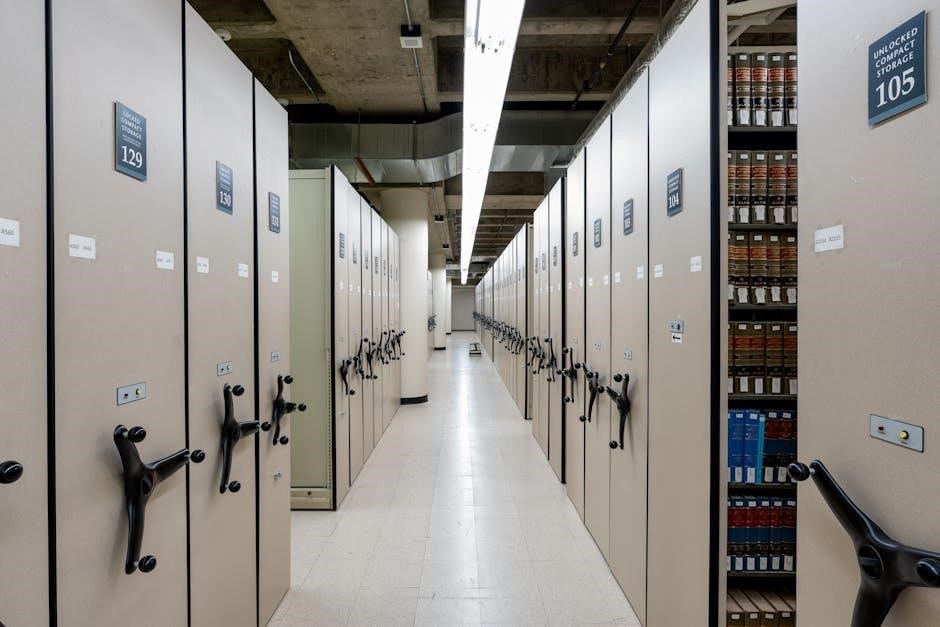This unit explores the far-reaching consequences of industrialization from 1750 to 1900‚ examining economic‚ social‚ political‚ environmental‚ and cultural impacts‚ as well as key ideologies driving expansion and societal transformation.
1.1. Overview of the Study Guide
This study guide provides a comprehensive framework for understanding the consequences of industrialization from 1750 to 1900. It is divided into key sections‚ each addressing specific aspects of industrialization‚ such as rationales for imperialism‚ environmental factors‚ economic transformations‚ and social changes. The guide emphasizes the interconnectedness of these themes‚ offering insights into how industrialization reshaped global economies‚ societies‚ and cultures. Learning objectives are clearly outlined to help students focus on critical concepts‚ such as the role of ideologies like Social Darwinism and the civilizing mission in driving imperial expansion. Additionally‚ the guide includes recommended reading materials‚ interactive activities‚ and resources like Quizlet flashcards to support deeper understanding. By exploring these topics‚ students will gain a nuanced perspective on the complex and far-reaching impacts of industrialization during this period.
1.2. Key Concepts and Learning Objectives
Key concepts in this unit include Social Darwinism‚ the civilizing mission‚ economic imperialism‚ and nationalism‚ which were central rationales for imperialism. Learning objectives focus on understanding how these ideologies contributed to imperial expansion and shaped global dynamics. Students will analyze the role of industrialization in driving economic transformations‚ environmental changes‚ and social shifts. They will also evaluate the impact of imperialism on colonized societies and the resistance movements that emerged. Additionally‚ the unit emphasizes the interconnectedness of industrialization and globalization‚ exploring how technological advancements and resource extraction influenced global trade and power structures. By the end of this unit‚ students will be able to explain the complex interplay of factors that defined the consequences of industrialization during this period.

Rationales for Imperialism (1750-1900)
Imperialism was justified through ideologies like Social Darwinism‚ the civilizing mission‚ and economic imperialism‚ which emphasized racial superiority‚ modernization‚ and resource exploitation to fuel industrial growth and national power.
2.1. Social Darwinism and Its Impact
Social Darwinism emerged as a prominent ideology during the 18th to 19th centuries‚ influencing imperialism by promoting the idea of racial and cultural superiority. This concept‚ inspired by Charles Darwin’s theory of natural selection‚ was misapplied to human societies‚ suggesting that certain races were inherently superior and destined to dominate others. European powers used Social Darwinism to justify their imperial expansion‚ claiming it was their duty to “civilize” lesser-developed societies. This ideology not only legitimized colonialism but also fueled nationalism and competition among industrialized nations. It emphasized survival of the fittest‚ creating a hierarchical view of the world that justified exploitation and violence against indigenous populations. Social Darwinism’s impact was profound‚ shaping global power dynamics and leaving lasting legacies of inequality and cultural suppression.
2.2. The Civilizing Mission
The Civilizing Mission was a central rationale for imperialism‚ asserting that Western nations had a moral duty to modernize and Westernize indigenous populations. Proponents argued that imperialism would bring advancements in society‚ technology‚ and governance to supposedly “backward” cultures. This ideology justified colonial expansion by framing it as a benevolent effort to uplift conquered peoples. Western powers often used education‚ religion‚ and infrastructure projects as tools to impose their values and systems. However‚ this mission frequently overlooked or dismissed local cultures and traditions‚ leading to cultural erasure and resistance. The Civilizing Mission also served to legitimize economic exploitation‚ as colonial powers extracted resources under the guise of “improving” the lives of colonized peoples. This paternalistic approach deeply shaped global power dynamics and left enduring legacies in colonized regions.
2;3. Economic Imperialism
Economic imperialism was a driving force behind colonial expansion‚ as industrialized nations sought raw materials and markets to fuel their economies. The Industrial Revolution intensified demand for resources like cotton‚ rubber‚ and minerals‚ which were often extracted from colonized regions. Imperial powers exploited these areas to establish export economies‚ focusing on cash crops and natural resources. This economic exploitation was justified as a means to modernize and integrate colonies into the global economy. However‚ it often led to the decline of local industries and enriched colonial powers at the expense of indigenous populations. Economic imperialism also fostered global trade imbalances‚ with industrialized nations benefiting disproportionately. The pursuit of economic gain became a primary motivator for imperialism‚ shaping global power dynamics and leaving lasting economic inequalities. This system reinforced the dominance of industrialized states over colonized regions.
2.4. Nationalism as a Driver of Imperialism
Nationalism played a significant role in shaping imperialist policies during the 18th to 19th centuries. As nations sought to assert their identity and dominance‚ imperialism became a means to demonstrate national strength and prestige. The rise of nationalist sentiments fueled competition among European powers‚ driving them to expand their territories and establish colonies. Nationalism also fostered a sense of superiority‚ as countries believed their culture and values were superior to those of colonized peoples. This ideology not only justified imperialism but also created a sense of duty to “civilize” other societies. The pursuit of national glory and economic resources became deeply intertwined‚ leading to intense rivalries and conflicts. Nationalist ambitions often overshadowed humanitarian concerns‚ prioritizing state interests over the well-being of colonized populations.

Environmental Factors and Global Economy
Industrialization increased demand for raw materials‚ driving global trade and exploitation of colonies. Geography influenced industrial growth‚ shaping resource extraction and economic expansion‚ impacting environmental sustainability.
3.1. The Need for Raw Materials
The Industrial Revolution created a surge in demand for raw materials like coal‚ iron‚ and cotton‚ essential for factory production and technological advancements. This demand drove the expansion of export economies‚ particularly in colonies‚ where resources were plentiful but often extracted under exploitative conditions. The need for these materials not only fueled economic growth in industrialized nations but also led to environmental degradation and resource depletion in colonized regions. Additionally‚ the scramble for resources intensified competition among European powers‚ contributing to the rise of imperialism. This period marked the beginning of a global economy heavily reliant on the extraction and trade of raw materials‚ shaping both economic systems and international relations for centuries to come.
3.2. Role of Geography in Industrial Growth
Geography played a pivotal role in shaping industrial growth during the 18th to 19th centuries. Regions with abundant natural resources‚ such as coal and iron‚ became hubs of industrial development‚ as these materials were essential for machinery and infrastructure. Britain‚ for instance‚ benefited from its vast coal deposits and navigable rivers‚ which facilitated transportation and energy production. Similarly‚ areas with strategic access to ports and trade routes‚ like Belgium and the Ruhr Valley in Germany‚ experienced rapid industrialization due to their ability to connect with global markets. Conversely‚ regions with limited resources or challenging terrain faced significant barriers to industrialization. Thus‚ geography not only influenced where industrialization occurred but also accelerated economic disparities between regions‚ shaping the global economic landscape for centuries to come.

Economic Transformations
Industrialization reshaped economies‚ fostering export growth‚ shifting from agrarian to industrialized systems‚ and creating global trade dependencies‚ while also intensifying inequalities and resource exploitation.
4.1. Growth of Export Economies
The Industrial Revolution created a surge in demand for raw materials‚ driving the expansion of export economies. Countries focused on producing industrial crops like cotton and rubber‚ as well as mining resources such as coal and iron. This shift transformed regions into specialized exporters‚ often at the expense of local food production. The growth of global trade networks facilitated the exchange of these goods‚ enriching industrialized nations while often exploiting colonies for their resources. The reliance on export economies deepened global interdependence but also led to environmental degradation and social inequalities. This economic transformation was central to the rise of industrialized powers and reshaped global economic systems during the 19th century.
4.2. Industrial Revolution and Global Trade
The Industrial Revolution significantly influenced global trade by creating new demands for raw materials and fostering technological advancements in transportation. Steamships and railways reduced trade costs and increased efficiency‚ enabling the rapid movement of goods. Industrialized nations sought colonies and overseas markets to secure resources and expand their influence. This period saw the rise of global trade networks‚ with industrialized countries at the center and raw material producers on the periphery. The growth of consumer goods and mass production further accelerated international trade‚ linking economies worldwide. However‚ this system often exploited colonized regions‚ deepening global economic inequalities. The integration of global markets during this era laid the foundation for modern economic interdependence‚ shaping the world economy for centuries to come.
4.3. Economic Models and Their Significance
Economic models during the Industrial Revolution played a crucial role in shaping global trade and industrial growth. Mercantilism‚ which emphasized state control over resources and trade‚ drove colonial expansion as nations sought raw materials and markets. Capitalism emerged as a dominant force‚ promoting free markets and industrialization. Socialist ideologies also arose‚ critiquing exploitation and advocating for workers’ rights. These models influenced policies‚ trade practices‚ and labor systems‚ shaping the global economy. Understanding these frameworks helps explain the economic transformations and inequalities of the time‚ as well as their lasting impact on modern economic systems.

Social Changes and Challenges
This section examines the social shifts and challenges resulting from industrialization‚ including urbanization‚ labor movements‚ and changes in social class structures‚ as well as the emergence of inequality and social stratification.
5.1. Urbanization and Its Consequences
Urbanization during the industrialization period led to rapid population growth in cities‚ driven by migration from rural areas. This resulted in overcrowding‚ poor housing conditions‚ and inadequate sanitation‚ fostering the spread of diseases. The rise of slums became a significant social issue‚ while the wealthy often lived in stark contrast‚ enjoying better living standards. Urban centers became hubs for industrial jobs‚ but workers faced long hours‚ low wages‚ and unsafe working conditions. This era also saw the emergence of class divisions‚ with the bourgeoisie controlling resources and the proletariat struggling to meet basic needs. Urbanization reshaped societal structures‚ creating both opportunities and challenges that fundamentally altered daily life and social dynamics during this transformative period.
5.2. Labor Movements and Workers’ Rights
Labor movements emerged as a response to the harsh working conditions brought by industrialization. Workers faced long hours‚ low wages‚ and unsafe environments‚ leading to widespread exploitation. The rise of unions and strikes became common‚ as workers sought collective bargaining power to demand better treatment. Key issues included child labor‚ minimum wage laws‚ and workplace safety regulations. These movements gained momentum‚ influencing governments to pass reforms such as factory acts and labor laws. The struggle for workers’ rights was central to addressing the social inequalities created by industrialization‚ ultimately shaping modern labor standards and protections that continue to evolve today.

5.3. Social Class Structures
Industrialization significantly reshaped social class structures‚ intensifying inequalities between the wealthy elite and the working poor. The middle class expanded‚ benefiting from new economic opportunities‚ while the working class faced exploitation in factories. Urbanization accelerated‚ leading to overcrowded living conditions and social unrest. The bourgeoisie‚ owning factories and capital‚ held immense power‚ contrasted with the proletariat‚ who relied on wage labor for survival. This division fueled tensions‚ inspiring movements like socialism and Marxism‚ which critiqued capitalist systems. Social mobility remained limited‚ perpetuating class divisions. The gap between classes widened‚ creating long-term social and economic challenges that shaped societal structures well beyond the industrial era.

Political Consequences
Industrialization led to the rise of nation-states‚ centralization of power‚ and the expansion of imperialism‚ as nations sought resources and markets to fuel their growing economies and political ambitions.
6.1. Rise of Nation-States
The rise of nation-states during the 18th to 19th centuries was closely tied to industrialization‚ as centralized governments sought to consolidate power and unify regions. Industrialization created new economic demands‚ fostering nationalism and the expansion of state authority. The unification of Germany and Italy exemplified this trend‚ as industrial might became a symbol of national strength. Imperialism further amplified the role of nation-states‚ as they competed for colonies and resources to fuel their economies. The interplay of industrial growth and political centralization reshaped global power dynamics‚ establishing nation-states as dominant political entities. This period laid the foundation for modern international relations‚ marked by both cooperation and conflict. The rise of nation-states was both a cause and consequence of industrialization‚ driving technological progress and economic transformation.
6.2. Imperialism and Colonialism
Imperialism and colonialism thrived during the 18th to 19th centuries‚ driven by industrialization’s demand for raw materials and new markets. European powers expanded their empires‚ exploiting colonies for resources like cotton‚ rubber‚ and minerals; The “civilizing mission” and Social Darwinism justified colonial rule‚ framing it as a duty to modernize “backward” societies. This period saw the scramble for Africa and Asia‚ with colonies serving as economic and political extensions of industrialized nations. However‚ colonialism also sparked resistance‚ as indigenous populations fought against exploitation and cultural erasure. The legacy of imperialism remains complex‚ marked by both economic integration and profound social upheaval. Industrialization and imperialism were deeply intertwined‚ shaping global power structures and cultural identities during this transformative era.
6.3. Resistance and Revolt Movements
Resistance and revolt movements emerged as responses to the exploitation and oppression brought by industrialization and imperialism. Colonized peoples and exploited laborers challenged oppressive systems‚ often through armed uprisings or political organizing. For example‚ the Indian Rebellion of 1857 and the Boxer Rebellion in China demonstrated resistance to colonial rule and cultural imposition. Labor movements in industrialized nations also gained momentum‚ advocating for workers’ rights and better conditions. These movements highlighted the social and political tensions created by industrialization‚ as marginalized groups sought to reclaim their rights and challenge the dominant power structures. Resistance efforts‚ while often suppressed‚ laid the groundwork for future reforms and independence movements‚ reshaping global dynamics in the late 19th and early 20th centuries.

Cultural Impacts
Industrialization reshaped cultural landscapes‚ spreading ideas like Social Darwinism and the civilizing mission‚ while technological advancements facilitated global cultural exchanges and shifts in societal values and norms.
7.1. Changes in Social Thought
Industrialization profoundly influenced social thought‚ fostering ideologies like Social Darwinism‚ which justified imperialism and racial superiority‚ and the civilizing mission‚ which aimed to modernize colonized societies. These ideas legitimized colonial expansion and economic exploitation‚ shaping global power dynamics. At the same time‚ industrialization sparked labor movements and calls for workers’ rights‚ challenging the status quo. Technological advancements and urbanization also shifted societal values‚ creating new cultural norms and fostering both unity and division. These changes in social thought laid the groundwork for modern political ideologies and ongoing debates about equality‚ justice‚ and global development.
7.2. Role of Technology in Cultural Shifts
Technology played a pivotal role in driving cultural shifts during the Industrial Revolution. Innovations like the steam engine‚ telegraph‚ and railways facilitated global communication and transportation‚ connecting distant regions and fostering cultural exchange. Urbanization‚ spurred by technological advancements‚ led to the rise of diverse city cultures. Mass production enabled the widespread dissemination of goods‚ influencing consumer behavior and lifestyles. Technological progress also challenged traditional beliefs and practices‚ promoting scientific inquiry and secularism. As a result‚ societies adopted more modern and interconnected identities‚ reshaping cultural norms and values. These technological advancements laid the foundation for the interconnected‚ rapidly evolving world of the 21st century.

Migration and Global Migrations
Migration during industrialization was driven by economic disparities‚ urbanization‚ and labor demands‚ reshaping societies and fostering cultural diversity while challenging traditional social structures and identities globally.
8.1. Patterns of Migration
Migration patterns during the period of industrialization were shaped by economic disparities‚ urbanization‚ and labor demands. People moved from rural areas to cities within their own countries‚ such as in Europe and Asia‚ seeking better opportunities. This internal migration laid the groundwork for international migration‚ as individuals and families traveled across borders to escape poverty or pursue employment in rapidly industrializing regions. Destinations like the Americas‚ Australia‚ and Southeast Asia became hubs for migrants‚ driven by the demand for labor in industries and colonies. These movements were often facilitated by colonial networks and the expansion of global trade. The scale of migration was unprecedented‚ with millions relocating‚ leading to significant cultural‚ social‚ and economic impacts. These patterns not only reshaped societies but also contributed to the interconnectedness of the global economy.
8.2. Impact on Global Economies
Migrations during the industrialization era significantly influenced global economies by redistributing labor forces and resources. Migrant workers provided essential labor for industrial growth‚ particularly in manufacturing and infrastructure projects‚ boosting productivity in regions like Western Europe and North America. Their remittances supported economic activities in their countries of origin‚ fostering trade connections. The movement of people also facilitated the exchange of goods‚ services‚ and technologies‚ strengthening global economic interdependence. However‚ migration sometimes led to labor exploitation and economic imbalances‚ as poorer nations lost skilled workers to wealthier regions. Overall‚ migration played a dual role in shaping economic growth and inequality‚ leaving a lasting impact on the global economy’s structure and development.

Study Guide Resources
Utilize recommended reading materials‚ interactive learning activities‚ and Quizlet flashcards to master key terms and concepts‚ ensuring a comprehensive understanding of industrialization’s consequences.
9.1. Recommended Reading Materials
To deepen your understanding of the consequences of industrialization‚ explore the following resources:
Textbooks: Utilize chapters from AP World History textbooks focusing on industrialization and its global impacts.
Articles: Review scholarly articles from universities like the University of Texas‚ Arlington‚ which provide detailed analyses of economic and social changes.
Online Guides: Refer to CliffsNotes and study guides that summarize key concepts and historical developments.
Primary Sources: Examine historical documents and speeches that highlight the ideologies behind imperialism and industrial growth.
Interactive Resources: Engage with online platforms like Quizlet for flashcards and Kahoot for interactive quizzes.
These materials will provide a comprehensive understanding of the topic‚ ensuring you are well-prepared for assessments and discussions.
9.2. Interactive Learning Activities
Engage with interactive learning activities to deepen your understanding of the consequences of industrialization.
Kahoot Quizzes: Participate in Kahoot sessions to test your knowledge of key terms and concepts.
Geography Mapping: Use online maps to analyze the spatial impact of industrialization and migration patterns.
Timeline Activities: Create and sequence events from 1750 to 1900 to understand the chronology of industrial and imperial developments.
Case Studies: Examine specific regions affected by industrialization and imperialism through interactive modules.
Discussion Forums: Engage in online discussions to explore diverse perspectives on the consequences of industrialization.
These activities enhance your learning experience‚ making complex historical concepts more accessible and engaging.
9.3. Quizlet Flashcards for Key Terms
Quizlet flashcards are an essential tool for mastering key terms related to the consequences of industrialization.
These flashcards provide concise definitions and explanations of critical concepts‚ such as Social Darwinism‚ the civilizing mission‚ and economic imperialism.
Students can use the digital platform to test their knowledge through interactive games and quizzes‚ ensuring retention of complex ideas.
Additionally‚ Quizlet allows users to search for specific terms and track their progress‚ making it a valuable resource for exam preparation.
Key terms include Social Darwinism‚ export economies‚ and nationalism‚ all of which are central to understanding the unit’s themes.
By leveraging Quizlet‚ learners can build a strong foundation for success in this unit and beyond.
The consequences of industrialization reshaped societies‚ economies‚ and cultures globally‚ leaving lasting impacts on modern life‚ from technological advancements to social inequalities and environmental challenges.
10.1. Summary of Key Points
In Unit 6‚ we examined the profound consequences of industrialization from 1750 to 1900. Key themes included the rise of imperialism‚ driven by ideologies like Social Darwinism‚ the civilizing mission‚ economic imperialism‚ and nationalism. Environmental factors‚ such as the need for raw materials‚ shaped global economies and industrial growth. Economic transformations like export economies and the Industrial Revolution reshaped trade patterns. Social changes‚ including urbanization and labor movements‚ highlighted challenges like class structures and workers’ rights. Political consequences involved the rise of nation-states and resistance movements against imperialism. Cultural impacts included shifts in social thought and technological advancements. Finally‚ migration patterns and their economic effects underscored the interconnectedness of the world during this period.
